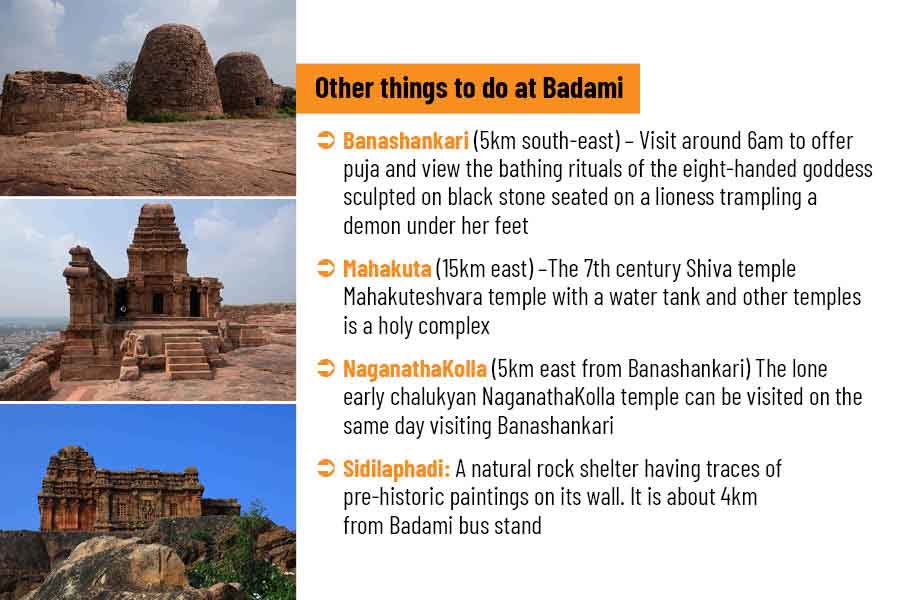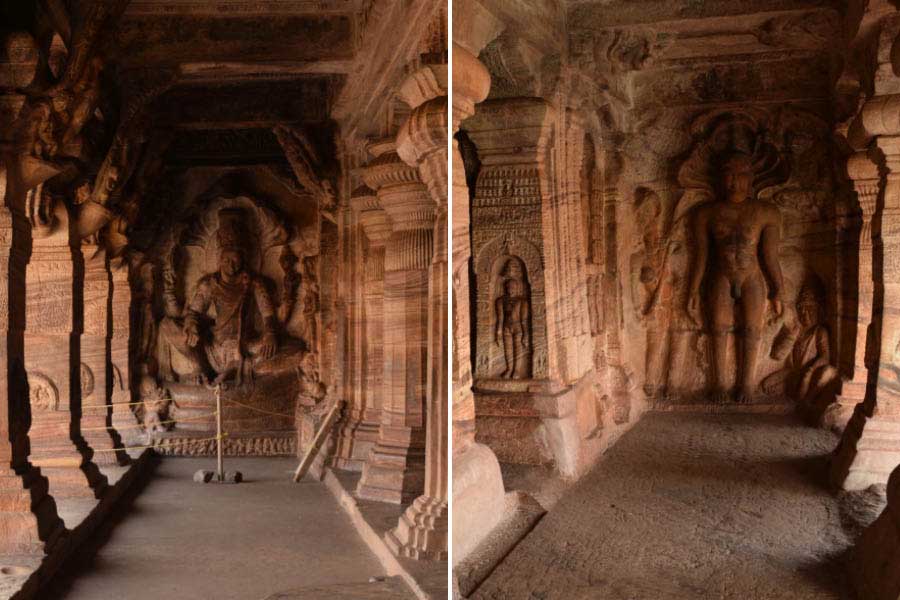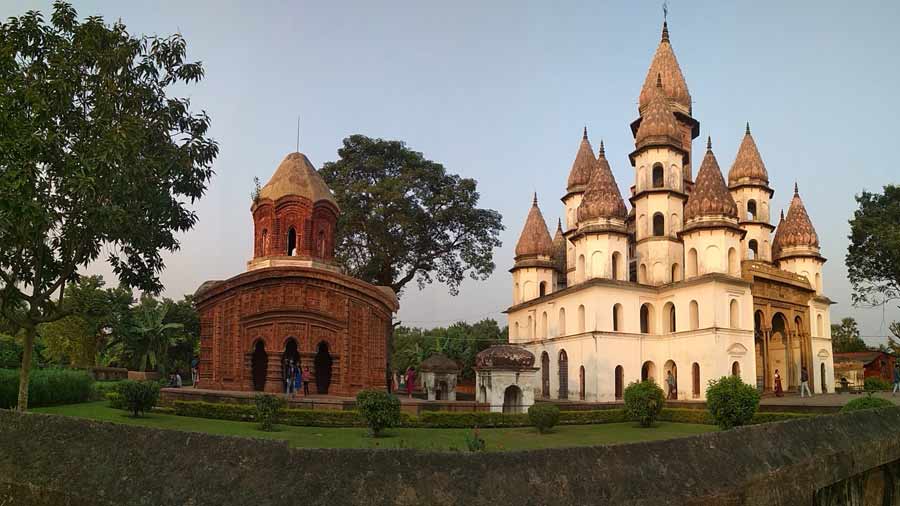Located in the Bagalkot district of Karnataka, the city of Badami is famous for its rock-cut cave temples, hilltop forts and prehistoric remains. According to local legend, Badami was originally named as Vatapipura or Vatapi, named after demon brothers Vatapi and Ilval, who were slain by saint Agastya.
The rise and fall of early Western Chalukyas in Badami
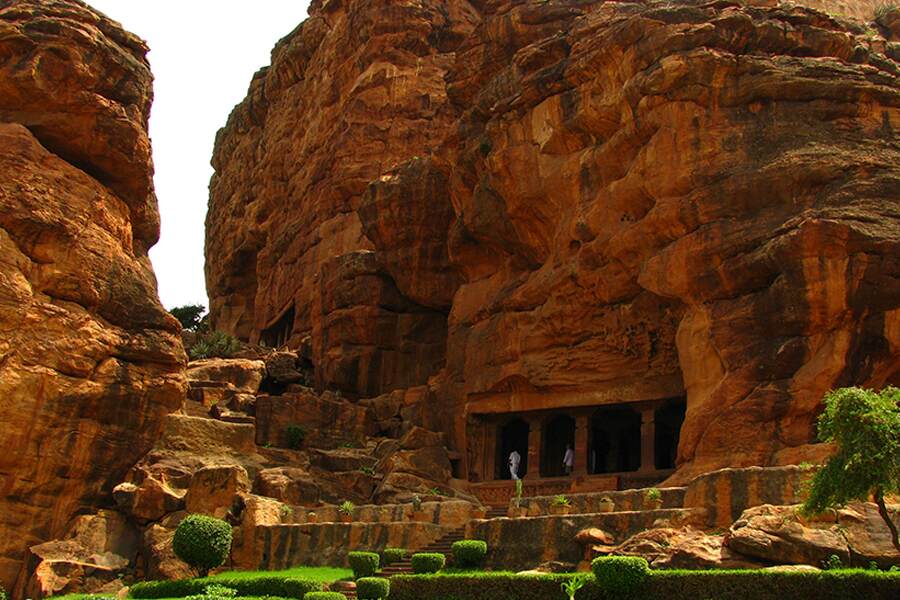
The entry point to the Badami cave temple complex.
Badami was the capital of early Western Chalukyas (535 to 757 CE.). Pulakeshi I (544-67) is considered the founder of the kingdom of early Western Chalukyas as an independent ruler who were earlier subordinates of Kadamba dynasty. His son, Kirttivarman I (567-98), started the architectural projects of building up rock-cut temples, at least one of which was completed by his younger brother, Mangalesha (598-610), as is evident from an inscription found in cave number 3.
Pulakesi II (610-642), the son of Kirtivarman I, subdued Mangalesha and extended his empire to Andhra Pradesh including laying the foundation of the eastern branch of early Chalukya family. Pulakeshi II was even mentioned by Hiuen Tsang during his visit to Maharashtra and Kanchipuram in 641.

The Pallava king, Narasimhavarman, defeated Pulakeshi II in 642-643. After a brief period of dominance by the Pallavas, the early Western Chalukyas again rose to power with Vikramaditya I (655–680 CE), the third son of Pulakeshi II. The last known ruler of this dynasty was Kirtivarman II in 757. Thereafter, the area was occupied by Rastrakutas, which subsequently became a part of Vijayanagar between the 13th and 16th centuries until their defeat in 1565. The Malprabha region was absorbed by the kingdom of Adil Shah Sultans. In 1778, Badami was taken over by Haidar Ali followed by Tipu Sultan. In 1786, Marathas took over the area. Finally, in 1818, the British attacked the city under General Thomas Munro and took over.

View of Northern Fort and Agastya Lake from cavern in between the cave temples.
There was some presence of early Chalukyas and later, late Chalukyas in the area even after Rashtrakutas took over the area as is evident from the presence of 8th to 9th century and 11th to 12th century temples in the vicinity.
A tour of Badami
Located in the Malprabha river valley surrounded by dramatic cliffs and spectacular ravines, the built heritages of Badami along with other two cities of early Western Chalukyas, Pattadkal (22km) and Aihole can be visited in details within a period of two to three days.
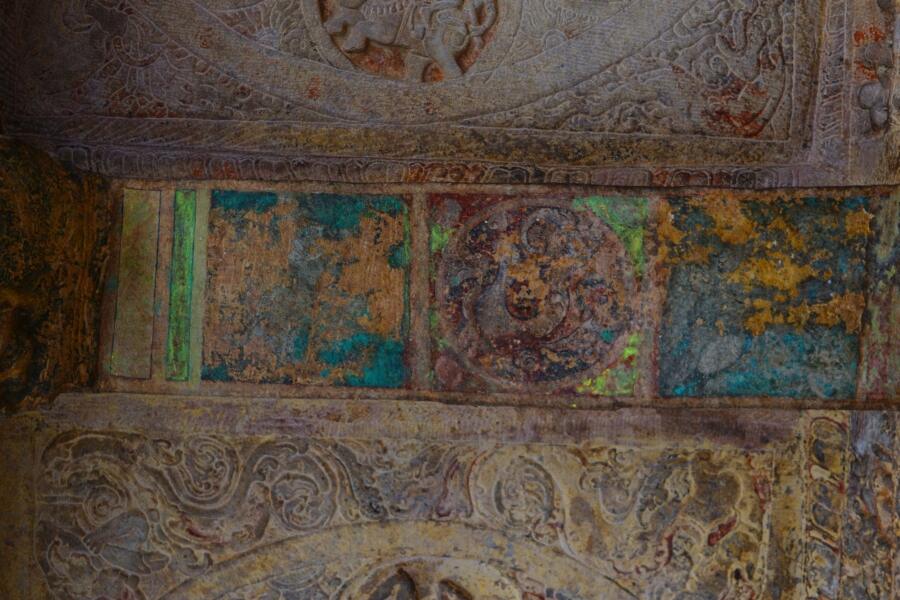
A fresco on the ceiling of cave number 3 at Badami.
The centre of tourist attraction of Badami is a hill fort having two parts, north and south, which are facing each other with a water tank in middle of them named Agastya Lake. On the eastern bank of Agastya Lake stands the eastern group of Bhutnatha temples and on the northern bank stands the north Bhutanatha group or Mallikarjuna group. The main temple of eastern group is of 8th century with its multi-storeyed tower caped with a kuta (hut shaped roof) but the rest others date to 12 centuries with pyramidal towers. There are many rock carvings related to Shiva, Vishnu and his avatars behind the eastern group.

Granaries inside Northern fort and (right) upper Shivalaya temple at Badami.
On its western bank stands the Badami slums housing some of the late Chalukya temples like Yellama temple (1139) and Virupaksha temple. The southern hillock houses the famous cave temples of Badami.
Start your tour after parking your vehicle in front of the Archaeological Survey of India ticket counter at Badami caves (open from 6am to 6pm) and proceed to the caves. There is a one-domed tomb built of red sandstone featuring characteristics of the Adil Shahi architecture just besides the car parking. This was erected by a local governor named Malik Abdul Aziz in memory of his wife.
Badami cave temples
Cut into the lower part of the north fort’s sandstone cliffs, the four monolithic cave temples of Badami positioned in four tiers are the magnum opus of the early Chalukya architects. There are three Brahmanical caves, a Jain cave and a natural cavern. Each of the cave temples with flat roofs have a verandah, which is supported by stone columns and brackets leading to a columned mandapa (maha mandapam) and finally to the small inner sanctum or garbhagriha. The ceilings of the caves features decorated medallion-shaped sculptures and ornate designs. The massive illars with vase-shaped kalasa and the cushion-shaped bulbous kumbha as capital components are carved with designs of jewelled garlands and roundels or circular decoration filled with foliate designs.
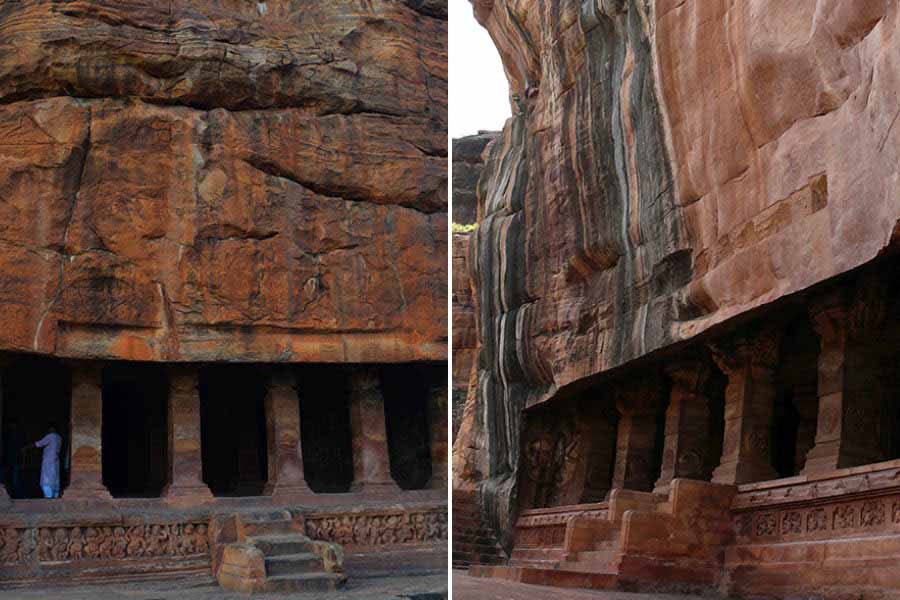
Cave temple numbers 1 and 3 at Badami.
There are sculpted panels at both ends of the verandahs in each cave, which depicts life-sized deities. There are several sculptures on the roof of the cave temples too. Check out the Vaikunthanath (Vishnu sitting on Shesh Nag) flanked by Varaha avatar rescuing goddess Bhudevi in Cave II, 18-handed dancing Shiva, Ardhanariswara, Mahishashurmardini Durga, Ganesh and Kartikeyain in Cave I and Vishnu as Trivikrama and Varaha in Cave III. Cave I is dedicated to Shiva, while II and III are to Vishnu. Cave IV displays sculptures of Mahavira, Parasnath and Gomata. The natural cavern is adorned by a seated deity adorned by a devotee which some scholars believe to be Jain tirthankara and some believes to be that of Padmapani. There is a locked door besides this cavern which once gave access to the southern fort.

The only cave having an inscription is Cave III (translated by archaeologist James Burgess) states that Mangalesha, a brother of king Kirthivarma I of Chalukya dynasty, completed it in 578 CE and granted the revenues of a village to this temple. This cave temple is the largest of any other such shrines at Badami adorned with paintings on its ceiling. As per Stella Kramrisch, these are not only the ‘earliest Brahmanical wall painting yet known in India’, but also the ‘earliest records of paintings in India which are definitely dated’ (Paintings at Badami, Journal of the Indian Society of Oriental Art, vol.4; no.1, 1936).
Northern Fort
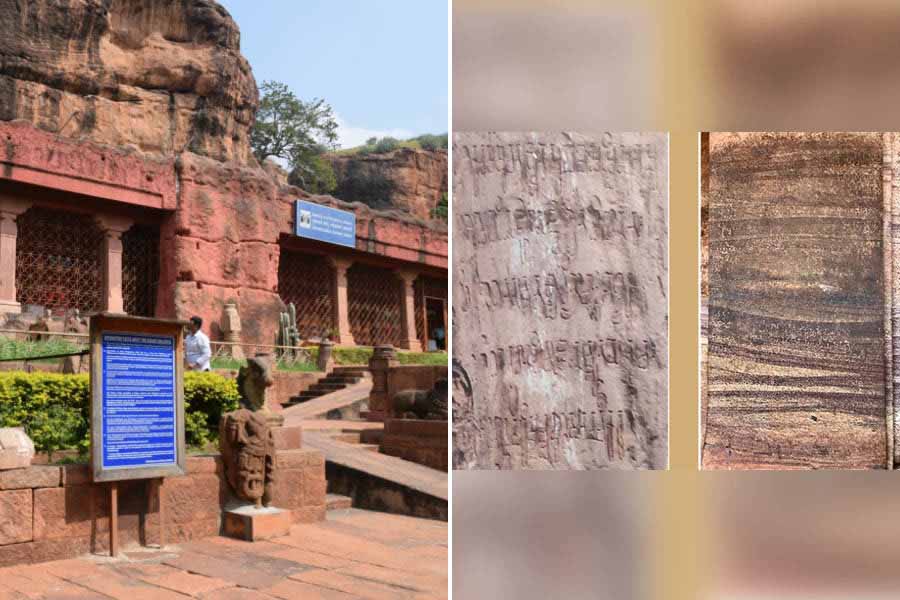
Archaeological Survey of India Museum, Badami, and (right) inscriptions on a cliff at Northern Cliff and inside cave temple number 3 at Badami. Photographs courtesy: ASI, Badami and Sarah Welch, Wikimedia Commons
You need to either walk through the narrow lanes of Badami slums to reach the road leading to the foothills of Northern Fort where the ASI Museum (9am to 6pm) is housed, or hire an autorickshaw to travel the distance.
The ASI Museum opens at 9am. The most highlighting exhibit in the museum is the Lajja Gauri sculpture from Naganatholla. In the ASI Museum complex, there is an inscription on a rock face providing details about the period of the brief occupancy of Pallava king Narasimhavarman in the area. Also in the Northern Fort in a most inaccessible cliff, there is an inscription which as per Durga Prasad Dikshit and other scholars mentions Chalukya Pulakeshi I as Vallabheshvara as performer of Aswamedha and other sacrifice in Shaka year 465 (543 CE).
A flight of stairs immediately after an arched gate takes one deep inside the Northern Fort. The fort houses two double-storeyed mandapas, two temples known as Upper and Lower Shivalaya, three granaries, a 1550-dated iron cannon, ruined complex of Maratha garrison and the renovated grave of Sayyid Hazrat Badshah Pir, a popular Muslim holy figure. The ramparts of the fort were in probability built during the rule of Tipu Sultan.
Located on the back side of the Northern Fort on a rock face, Malelligiti Shivalaya can only be accessed by a lane from the Main road. This is the finest specimen from Early Chalukyas time. It presents an open porch and triple aisled Mandapa with its wall having exquisite sculptures which includes both Shaivism and Vaishnavism artwork. During Monsoon, one can hike up the hills beyond Bhutnath Temples to view the Akki Tangi waterfalls in full flow.
